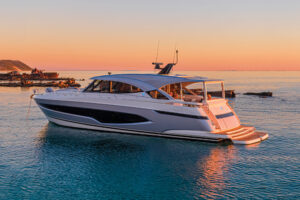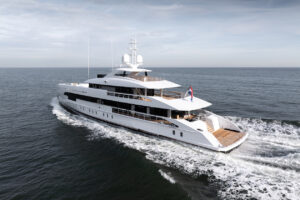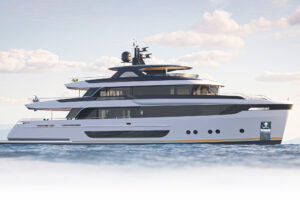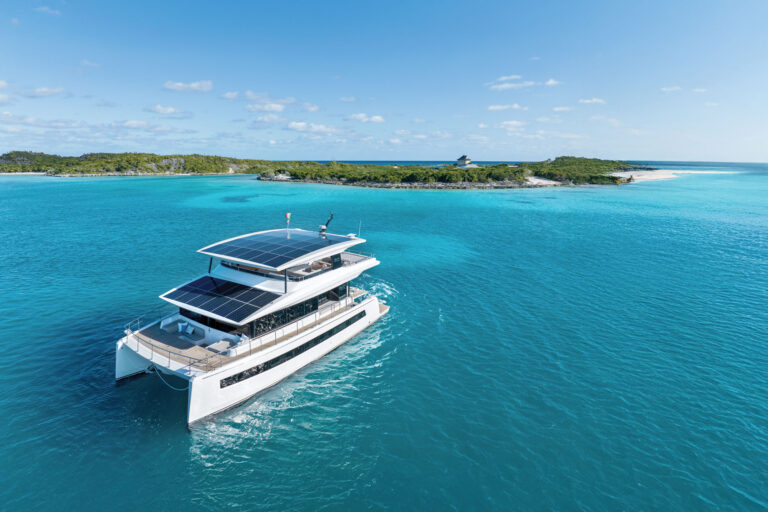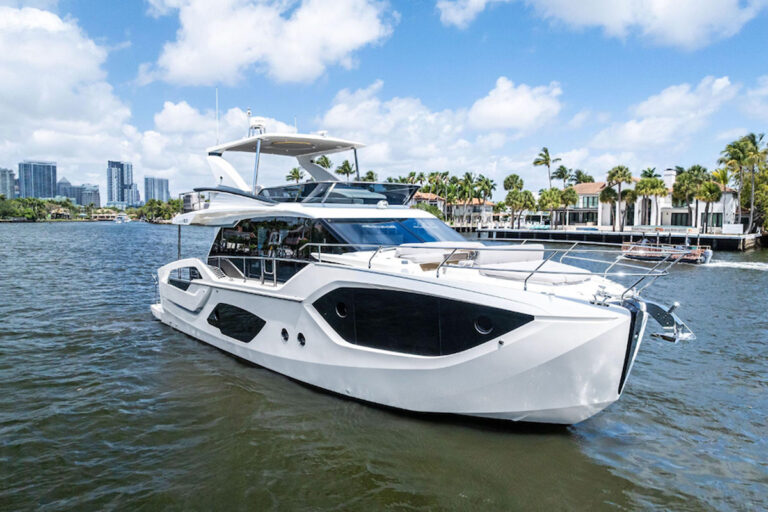I had the pleasure of meeting Richard Garlington 20 years ago, shortly after he launched his first 48-footer. The design was ahead of its time and ahead of the competition. Sadly, Garlington passed away in 2003, however, the company he launched enjoys continued success thanks in large part to an equally innovative design—this time, the Garlington 61.
The 61 came to be shortly after Peter and Everet Landeweer purchased the company (ergo Garlington Landeweer) in 1993.
The transplanted Dutch yachtsmen admired Garlington’s cold-molded 58-footer and felt the timing and technology were right for a tournament-class sportfisherman in lightweight fiberglass. Recently, I inspected and performed a sea trial with the custom-built Patricia, the 19th Garlington 61, and visited the facility where she was produced.
At first glance Garlington Landeweer’s steel sheds look no different from those that belong to the others in Stuart, Florida’s, small flock of custom fishboat builders. That is, until you notice the hull and superstructure tooling scattered about the shop floor. Such fixtures are sacrilege for some purists, as wood construction still dominates this highly specialized market.
True believers will tell you that cold-molded sportfishermen are lighter and faster, and that the resonance of diesel and wood in the water can raise more fish. Peter Landeweer obviously disagrees. “Good captains and good anglers raise more fish”, he insists. Indeed, the 61 has played an important part in changing the way serious fishermen feel about fiberglass.
Early on, Landeweer committed to investing in the latest composite technologies to compete in terms of weight. “For the last 10 years we have tried to stay ahead of the curve by maintaining close working relationships with our suppliers as well as independent composite experts”, he said.
The 61’s hull-bottom laminate is a “club sandwich” comprising two layers of 1 1/4-inch Core-Cell foam, a stitched multi-directional blend of Kevlar and fiberglass reinforcement and vinylester resin. Fiberglass stringers are supported by cored web frames and six cored structural bulkheads bonded to the hull and the superstructure. Carbon fiber is used locally, in areas where its tensile strength is an advantage. The superstructure and decks also are built with Core-Cell. Garlington Landeweer vacuum-bags all core materials to ensure proper bonding, and all exterior surfaces have an Imron finish.
Non-structural interior bulkheads and joinery are built on a lightweight honeycomb substrate, and the foam-cored saloon sole is stiffened with pultruded fiberglass I-beams. The result is a relatively rigid and durable structure. Her displacement of approximately 54,000 pounds (dry) is competitive with those of cold-molded boats and significantly lighter than those of boats built with conventional single-skin, production fiberglass.
My sea trial aboard Patricia provided proof that trimming pounds pays off. She is equipped with Landeweer’s current engines of choice, twin MTU 12V2000s. With a two-thirds load of fuel, an impressive tower crafted by Jack Hopewell and her owner’s gear aboard, I recorded a top speed of 41.1 knots. When pulled back to 2100 rpm, she still charged along at 37.8 knots. At 32 knots (1800 rpm) I noted a fuel burn of 90 gallons per hour. At 1850 rpm, sound levels in the saloon were a pleasant 82 decibels. Speed is an important measure in the custom sportfisherman market, and the 61 has what it takes.
Her pod-style tournament helm is perfectly proportioned for comfort and visibility. Given throttle, she rises evenly to plane and runs cleanly at speed. Trim tabs are necessary only for minor adjustments to athwartships trim. Trolling valve-equipped, she can easily loiter at live-bait speed (slooow). While we did not make it offshore, her captain, Elliott Cline, took her fresh out of the box to the Turks and Caicos Islands prior to my visit. The 1,000-mile round trip included several days in steep seas that Patricia managed to calm, said Cline.
Her hull form has a fine entry forward and inverted bell-shape sections aft. With a transom deadrise of about 22 degrees, she is relatively deep, which suits her speed potential and offshore service. To reduce drag, transducers and strut palms are flush-mounted, integral sea chests eliminate the need for individual seawater intakes, and common drains limit the number of discharge through-hulls.
Access to the engineroom is from the cockpit. The 12V2000s are a tight fit, but access is acceptable. Reflective material on the overhead allows inspection of the top of the engines without twisting your neck, a nice touch. A second access/emergency egress hatch is in the galley. This is a sensible safety feature I wish were more common in production-boat designs. Should a serious mechanical problem arise, the saloon sole incorporates three large hatches through which the engines are installed. Two 20kW Northern Lights generators are aft by the entryway. Engine foundations and tankage are built of aluminum. Bilges are spotless.
Garlington Landeweer attempts to simplify systems. When a boat wanders far from the dock, reliability is an asset that captains and owners appreciate. Every unnecessary relay, connection, sensor and sender is an unnecessary potential problem.
While the 61’s hull and superstructure are defined by female tooling, little else is standard. For example, two 61s built for clients who operate in skinny water were designed with propeller tunnels, which reduced their draft to just 3 feet, 10 inches. One 61 was built for cruising the Med and has an extended bridge deck designed to carry a tender. The variations on interior layout are virtually limitless. Several arrangements on file typically provide the starting point. Patricia’s three-stateroom layout seems ideal for a boat her size.
Building a lightweight composite structure can be relatively easy compared with keeping the weight of the finish trim and décor under control; granite statuary is not an option on the 61. Interior designer Sam Rowell specializes in tournament sportfishermen and worked closely with Patricia’s owners, Dan and Pat McGlaughlin. The satin-finished teak, fluted joinery details and teak-and-walnut soles are memorable. Patricia will be fished in comfort from Stuart to Costa Rica.
While the success of Patricia and her sisters has spawned 72-foot and 80-foot models (built for Garlington Landeweer in New Zealand), the 61 remains the company’s signature design and one of the most pleasing profiles on the water.
Contact: Garlington Landeweer Marine, Inc., (772) 283-7124; www.garlingtonyachts.com

